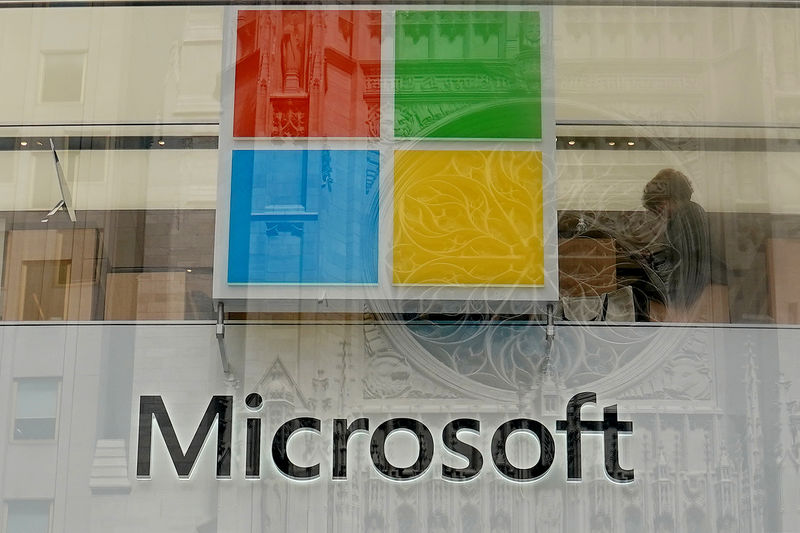US stock futures muted as rate cut bets wane ahead of Jackson Hole
On Thursday, Goldman Sachs reiterated its Buy rating and $500.00 price target for Microsoft Corporation (NASDAQ:MSFT), following the company’s mixed financial results for the second quarter of fiscal year 2025. The investment firm pointed to the ongoing investor concerns over the growth pace of Microsoft’s Azure cloud services, which contributed to a 5% post-market decline in the stock price. Despite these concerns, Goldman Sachs highlighted positive developments in Microsoft’s capital expenditures (CapEx) and earnings per share (EPS) revisions. With a market capitalization of $3.29 trillion and an overall "GREAT" financial health score according to InvestingPro, Microsoft continues to demonstrate strong fundamentals, though current trading levels suggest the stock is slightly overvalued based on Fair Value estimates.
Microsoft’s management has provided guidance indicating CapEx will be around $22-23 billion per quarter in the second half of fiscal year 2025, suggesting a clearer view of future capital spending and a balance between supply and demand constraints. Goldman Sachs analysts anticipate a significant reduction in CapEx for fiscal year 2026 due to the front-loading of data center investments. As Microsoft continues to expand its capacity, focus on artificial intelligence (AI) opportunities, and improve its execution of Azure, analysts see potential for Azure’s growth to accelerate again in the fourth quarter of fiscal year 2025. The company’s strong revenue growth of 16.44% and impressive return on equity of 36% support its aggressive investment strategy.
The firm also noted Microsoft’s in-quarter EPS outperformance, which was 4% higher than Goldman Sachs’ estimates, and the minimal changes to the third-quarter fiscal year 2025 guidance, breaking a pattern of negative revisions. These factors suggest that Microsoft might be at an EPS inflection point, despite the high CapEx cycle over the trailing twelve months. Goldman Sachs believes that Microsoft is well-positioned to absorb investment cycle expenses, which could lead to operating margin expansion and sustained earnings strength.
Microsoft’s current trading multiple of 36 times its fiscal year 2026 enterprise value to free cash flow (EV/FCF) is seen as a discount compared to Oracle (NYSE:ORCL)’s 47 times multiple. Oracle has a $97 billion book of business and is also increasing its CapEx profile. Goldman Sachs prefers Microsoft’s stock at its current levels due to the company’s roughly $300 billion in remaining performance obligations (RPO), rapidly growing AI revenue, which is on track to reach a $13 billion annual run rate (up 175% year-over-year), strong commercial bookings up 75% year-over-year, EPS growth, and an established position in AI. Trading near its 52-week high of $468.35, Microsoft maintains a P/E ratio of 36.48x and demonstrates robust cash flows. For deeper insights into Microsoft’s valuation and growth metrics, including 16 additional ProTips and comprehensive financial analysis, visit InvestingPro to access the detailed Pro Research Report.
In other recent news, Microsoft reported a second-quarter revenue of $69.6 billion, marking a 12% increase year-over-year. The tech giant’s commercial bookings surged due to a significant commitment from OpenAI, contributing to a 33% year-over-year growth in remaining performance obligations. Analysts from JPMorgan maintained an Overweight rating on Microsoft, while Morgan Stanley (NYSE:MS) reduced its price target to $530, citing concerns about increased foreign exchange headwinds and potential losses associated with OpenAI. DA Davidson holds a Neutral stance with a $425 target, and BofA Securities maintains a Buy rating with a $510 target. These are recent developments in the technology sector.
Microsoft’s Azure growth for the second quarter was at the lower end of the guided range, with the third quarter guidance also below consensus. Despite these challenges, Microsoft has shown impressive overall revenue growth. On the other hand, the company’s partnership with OpenAI has been seen as a positive signal, contributing significantly to commercial bookings.
Microsoft anticipates maintaining similar capital expenditure levels for the next two quarters. The company’s strategy seems to be adapting to a potential shift in value from the large language model component to the application and infrastructure layers. The tech giant is laying the groundwork for long-term success in areas such as security, Teams, Power Apps, and its investments in OpenAI and ChatGPT.
This article was generated with the support of AI and reviewed by an editor. For more information see our T&C.
